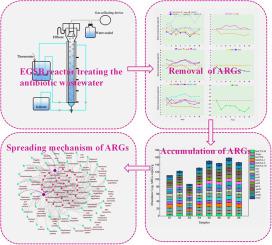Ecotoxicology and Environmental Safety ( IF 6.2 ) Pub Date : 2021-09-04 , DOI: 10.1016/j.ecoenv.2021.112714 Lingwei Meng 1 , Yuzhe Zhao 1 , Xiangkun Li 2 , Yanli Kong 3 , Jingbo Guo 1 , Mingwei Liu 1

|
To explore the fate and spreading mechanism of antibiotics resistance genes (ARGs) in antibiotics wastewater system, a laboratory-scale (1.47 L) Expanded Granular Sludge Bed (EGSB) bioreactor was implemented. The operating parameters temperature (T) and hydraulic retention time (HRT) were mainly considered. This result showed the removal of ARGs and COD was asynchronous, and the recovery speed of ARGs removal was slower than that COD removal. The decreasing T was attributed to the high growth rate of ARGs host bacteria, while the shortened HRT could promote the horizontal and vertical gene transfer of ARGs in the sludge. The analysis result of potential bacterial host showed more than half of the potential host bacteria carried 2 or more ARGs and suggested an indirect mechanism of co-selection of multiple ARGs. Phylogenetic Investigation of Communities by Reconstruction of Unobserved States (PICRUSt) was used to investigate the functional characteristics of bacterial community. This result showed the bacterial functional genes contributed 40.41% to the abundance change of ARGs in the sludge, which was higher that of bacterial community. And the function genes of “aromatic hydrocarbon degradation”, “Replication, recombination and repair proteins” and “Flagellar assembly” were mainly correlated with the transfer of ARGs in the sludge. This study further revealed the mechanism of ARGs spread in the EGSB system, which would provide new ideas for the development of ARGs reduction technology.
中文翻译:

膨胀颗粒污泥床反应器处理抗生素废水细菌功能特性对抗生素抗性基因传播的影响
为了探索抗生素废水系统中抗生素抗性基因 (ARG) 的命运和传播机制,实施了实验室规模 (1.47 L) 膨胀颗粒污泥床 (EGSB) 生物反应器。主要考虑操作参数温度(T)和水力停留时间(HRT)。该结果表明ARGs和COD的去除是异步的,并且ARGs去除的恢复速度比COD去除慢。降低的 T 归因于 ARGs 宿主细菌的高生长速率,而缩短的 HRT 可以促进污泥中 ARGs 的水平和垂直基因转移。潜在细菌宿主的分析结果显示,超过一半的潜在宿主细菌携带2个或更多ARGs,提示多个ARGs共同选择的间接机制。通过重建未观察到的状态(PICRUSt)对群落进行系统发育调查(PICRUSt)用于调查细菌群落的功能特征。该结果表明,细菌功能基因对污泥中ARGs丰度变化的贡献率为40.41%,高于细菌群落。而“芳香烃降解”、“复制、重组和修复蛋白”和“鞭毛组装”的功能基因主要与污泥中ARGs的转移相关。本研究进一步揭示了ARGs在EGSB系统中的扩散机制,为ARGs还原技术的发展提供了新的思路。该结果表明,细菌功能基因对污泥中ARGs丰度变化的贡献率为40.41%,高于细菌群落。而“芳香烃降解”、“复制、重组和修复蛋白”和“鞭毛组装”的功能基因主要与污泥中ARGs的转移相关。本研究进一步揭示了ARGs在EGSB系统中的扩散机制,为ARGs还原技术的发展提供了新的思路。该结果表明,细菌功能基因对污泥中ARGs丰度变化的贡献率为40.41%,高于细菌群落。而“芳香烃降解”、“复制、重组和修复蛋白”和“鞭毛组装”的功能基因主要与污泥中ARGs的转移相关。本研究进一步揭示了ARGs在EGSB系统中的扩散机制,为ARGs还原技术的发展提供了新的思路。











































 京公网安备 11010802027423号
京公网安备 11010802027423号